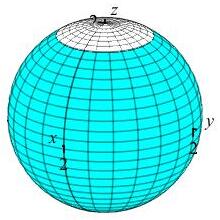22. Parametric Surfaces and Surface Integrals
d. Applications of Scalar Surface Integrals
2. Mass
The total mass is always the integral of the density, \(\delta\), over the region. In the case of parametric surfaces, the density is given in units of \(\dfrac{\text{mass}}{\text{area}}\) and the mass is then \[ M=\iint_S \delta\,dS =\iint_S \delta(\vec R(u,v))\,|\vec{N}|\,du\,dv \]
A polar ice cap covers the top of a sphere of radius \(2\) down to the angle \(\phi=\dfrac{\pi}{6}\). Find the mass of the ice cap, given that the surface density is \(\delta=z^2-3\).

The sphere is parametrized by: \[ \vec R(\phi,\theta) =\left\langle 2\sin\phi\cos\theta,2\sin\phi\sin\theta,2\cos\phi\right\rangle \] In these coordinates, the density is \(\delta=z^2-3=4\cos^2\phi-3\). On a previous page, we found that \(|\vec{N}|=4\sin\phi\). So the total mass is: \[\begin{aligned} M&=\iint_P \delta\,dS =\iint_P \delta(\theta,\phi)|\vec{N}|\,d\phi\,d\theta \\ &=\int_0^{2\pi}\int_0^{\pi/6} (4\cos^2\phi-3)4\sin\phi\,d\phi\,d\theta \\ &=8\pi\int_0^{\pi/6} (4\cos^2\phi-3)\sin\phi\,d\phi \\ \end{aligned}\]
Here we use the substitution \(u=\cos\phi\). So \(du=-\sin\phi\,d\phi\). Therefore, the mass becomes: \[\begin{aligned} M&=-8\pi\int_1^{\sqrt{3}/2} (4u^2-3)\,du =-8\pi\left[4\dfrac{u^3}{3}-3u\right]_1^{\sqrt{3}/2} \\ &=-8\pi\left[\left(4\dfrac{3\sqrt{3}}{3\cdot8}-\,\dfrac{3\sqrt{3}}{2}\right) -\left(\dfrac{4}{3}-3\right)\right] \\ &=8\pi\sqrt{3}-\,\dfrac{40}{3}\pi \approx1.643 \end{aligned}\]
Find the mass of the piece of the paraboloid \(z=\dfrac{x^2+y^2}{5}\) below \(z=5\) if the surface density is \(\delta=\dfrac{1}{\sqrt{\dfrac{4z}{5}+1}}\). The length of the normal vector was found in a previous exercises.
\(\displaystyle M=25\pi\)
The paraboloid is parametrized by: \[ \vec R(r,\theta)=\left\langle r\cos\theta,r\sin\theta,\dfrac{r^2}{5}\right\rangle \] and the length of the normal is: \[ |\vec N|=r\sqrt{\dfrac{4r^2}{25}+1} \] We compute the density: \[ \delta=\dfrac{1}{\sqrt{\dfrac{4z}{5}+1}} =\dfrac{1}{\sqrt{\dfrac{4r^2}{25}+1}} \] So the mass is: \[\begin{aligned} M&=\iint_S \delta\,dS =\int_0^{2\pi}\int_0^5 \dfrac{1}{\sqrt{\dfrac{4r^2}{25}+1}}r\sqrt{\dfrac{4r^2}{25}+1}\,dr\,d\theta \\ &=2\pi\int_0^5 r\,dr =\pi\left[\rule{0pt}{10pt}r^2\right]_0^5 =25\pi \end{aligned}\]
Heading
Placeholder text: Lorem ipsum Lorem ipsum Lorem ipsum Lorem ipsum Lorem ipsum Lorem ipsum Lorem ipsum Lorem ipsum Lorem ipsum Lorem ipsum Lorem ipsum Lorem ipsum Lorem ipsum Lorem ipsum Lorem ipsum Lorem ipsum Lorem ipsum Lorem ipsum Lorem ipsum Lorem ipsum Lorem ipsum Lorem ipsum Lorem ipsum Lorem ipsum Lorem ipsum